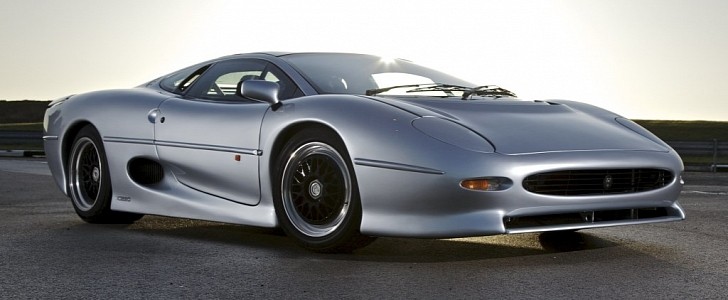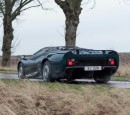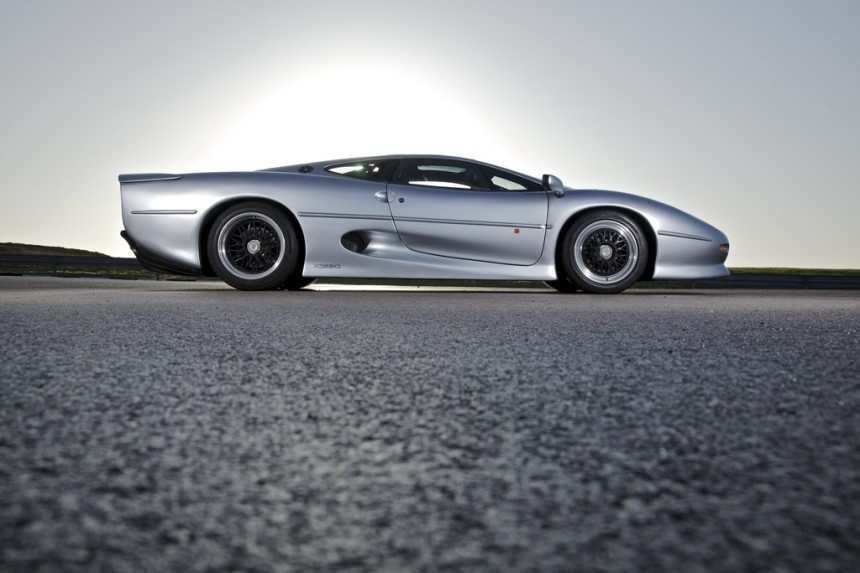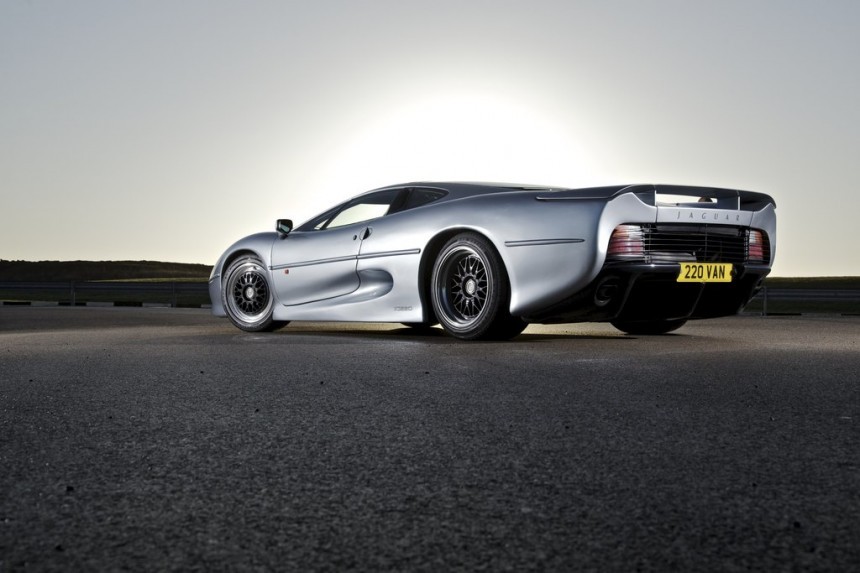The Ford Motor Company spent $2.5 billion on Jaguar in a deal that closed in 1990, the year of my birth. It’s also worth remembering the Dearborn-based automaker shelled out approximately $10 billion trying to revive the Leaping Cat of Coventry. A part of that money went into the XJ220, a limited-run supercar that was greenlit for production in December 1989.
The XJ220 project can trace its roots back to December 1987 and director of engineering Jim Randle. A Porsche 956-inspired mockup and an XJ13 lookalike were produced by Jaguar’s design studio. Penned by principal stylist Keith Helfet, the second option was chosen as the starting point for the exterior design because it looked more like a Jaguar than the other mockup.
Being a little short on cash, the XJ220 didn’t have too much support from Jaguar. Randall wasn’t the kind of man to give up easily, which is why he gathered a team of volunteers that didn’t mind working evenings and weekends on this enthusiastic project. Thus, the Saturday Club was born.
The 12 gentlemen responsible for getting the XJ220 off the ground agreed on a mid-engine layout and V12 power in the guise of a race-bred 6.2 with approximately 500 horsepower on tap. The Saturday Club also envisioned all-wheel drive and all-wheel steering, along with scissor doors. The concept was completed at 3 AM in the early morning of October 18th, 1988, the very same day it was unveiled at 11 AM at the British Motor Show.
Showstopper would be the perfect word to describe what followed suit. For example, the Prancing Horse of Maranello was displaying the F40 next to Jaguar’s design study. Ferrari got so desperate to attract visitors to their stand that they brought a scantily clad lady. To no avail, of course, even though Fezza had the last laugh considering the F40’s current valuation.
Fast forward to 1989. That December, the British manufacturer announced a pre-tax price of £290,000 and a production run of 350 vehicles. Approximately 1,400 reservations were recorded, each complemented by a £50,000 deposit. Be that as it may, Jaguar couldn’t keep its promises.
In addition to aerodynamic changes, the Ford-owned automaker had to switch to rear-wheel drive and ditch all-wheel steering. The biggest change from the original design is the powerplant. Instead of a naturally-aspirated V12, a twin-turbocharged V6 was used instead. This deviation also translated to a shorter wheelbase: 2,640 compared to 2,840 millimeters.
As you’d expect, many prospective customers weren’t having it even though Porsche’s cult-classic 959 was rocking a twin-turbocharged sixer as well. Those customers, however, didn’t know that Jaguar and technical partner Tom Walkinshaw Racing would deliver the fastest car of its era.
It’s all in the name: 220 miles per hour (354 kilometers per hour). But in truth, the XJ220 was proven to 217.1 miles per hour (349.4 kilometers per hour) with the catalytic converters and rev limiter deleted. The XJ220 soldiered on as the fastest production car in the world until the McLaren F1 broke record after record. Come March 1998, the XP5 prototype of the McLaren F1 was taken to an outstanding 240.1 mph (386.4 kph) by Andy Wallace.
The very production car was unveiled by Diana, Princess of Wales, at the Bloxham factory in October 1991. Indeed, it’s the very same assembly facility where the Jaguar XJR-15 and Aston Martin DB7 were produced.
Deliveries began in June 1992, and by this time, the sticker price had ballooned to £470,000. Adjusted for inflation, that’s £1,036,405 nowadays or $1,389,310 at current exchange rates. The final example was finished in April 1994 when Bloxham was retooled for the Jaguar XJS-based DB7.
A grand total of 282 units were produced, of which 69 were delivered in right-hand drive. The Brunei Royal Family purchased 18 units, of which a right-hand-drive XJ220 morphed into the superb Pininfarina Speciale.
Rated at 542 horsepower and tipping the scales at 1,470 kilograms (3,241 pounds), the ill-fated XJ220 came exclusively with a five-speed manual transaxle and a viscous coupling limited-slip differential. Gifted with Rover 200 taillights and Ford-sourced tidbits for the interior, the V6-engined feline wasn’t officially sold in the United States even though the North American market would have brought a few more customers into the fold.
Jaguar revealed the C-X75 at the 2010 Paris Motor Show, but the 778-hp spiritual successor of the XJ220 never saw the light of series production. On that note, the XJ220 remains ingrained in the automotive pantheon as both a high and a low point for the Coventry-based manufacturer.
Being a little short on cash, the XJ220 didn’t have too much support from Jaguar. Randall wasn’t the kind of man to give up easily, which is why he gathered a team of volunteers that didn’t mind working evenings and weekends on this enthusiastic project. Thus, the Saturday Club was born.
The 12 gentlemen responsible for getting the XJ220 off the ground agreed on a mid-engine layout and V12 power in the guise of a race-bred 6.2 with approximately 500 horsepower on tap. The Saturday Club also envisioned all-wheel drive and all-wheel steering, along with scissor doors. The concept was completed at 3 AM in the early morning of October 18th, 1988, the very same day it was unveiled at 11 AM at the British Motor Show.
Showstopper would be the perfect word to describe what followed suit. For example, the Prancing Horse of Maranello was displaying the F40 next to Jaguar’s design study. Ferrari got so desperate to attract visitors to their stand that they brought a scantily clad lady. To no avail, of course, even though Fezza had the last laugh considering the F40’s current valuation.
In addition to aerodynamic changes, the Ford-owned automaker had to switch to rear-wheel drive and ditch all-wheel steering. The biggest change from the original design is the powerplant. Instead of a naturally-aspirated V12, a twin-turbocharged V6 was used instead. This deviation also translated to a shorter wheelbase: 2,640 compared to 2,840 millimeters.
As you’d expect, many prospective customers weren’t having it even though Porsche’s cult-classic 959 was rocking a twin-turbocharged sixer as well. Those customers, however, didn’t know that Jaguar and technical partner Tom Walkinshaw Racing would deliver the fastest car of its era.
It’s all in the name: 220 miles per hour (354 kilometers per hour). But in truth, the XJ220 was proven to 217.1 miles per hour (349.4 kilometers per hour) with the catalytic converters and rev limiter deleted. The XJ220 soldiered on as the fastest production car in the world until the McLaren F1 broke record after record. Come March 1998, the XP5 prototype of the McLaren F1 was taken to an outstanding 240.1 mph (386.4 kph) by Andy Wallace.
Deliveries began in June 1992, and by this time, the sticker price had ballooned to £470,000. Adjusted for inflation, that’s £1,036,405 nowadays or $1,389,310 at current exchange rates. The final example was finished in April 1994 when Bloxham was retooled for the Jaguar XJS-based DB7.
A grand total of 282 units were produced, of which 69 were delivered in right-hand drive. The Brunei Royal Family purchased 18 units, of which a right-hand-drive XJ220 morphed into the superb Pininfarina Speciale.
Rated at 542 horsepower and tipping the scales at 1,470 kilograms (3,241 pounds), the ill-fated XJ220 came exclusively with a five-speed manual transaxle and a viscous coupling limited-slip differential. Gifted with Rover 200 taillights and Ford-sourced tidbits for the interior, the V6-engined feline wasn’t officially sold in the United States even though the North American market would have brought a few more customers into the fold.
Jaguar revealed the C-X75 at the 2010 Paris Motor Show, but the 778-hp spiritual successor of the XJ220 never saw the light of series production. On that note, the XJ220 remains ingrained in the automotive pantheon as both a high and a low point for the Coventry-based manufacturer.



























